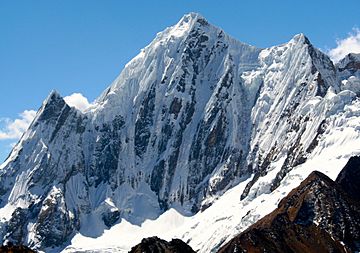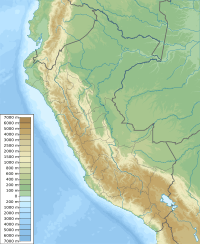Rasac facts for kids
Quick facts for kids Rasac |
|
|---|---|

South face of Rasac, July 2010
|
|
| Highest point | |
| Elevation | 6,017 m (19,741 ft) |
| Geography | |
| Parent range | Andes, Huayhuash |
| Climbing | |
| First ascent | unknown |
| Easiest route | glacier/snow/ice climb |
Rasac is a tall mountain located in the Huayhuash mountain range in central Peru. This mountain range is part of the larger Andes mountains, which stretch along the western side of South America. The name "Rasac" might come from the Quechua language, meaning "toad."
Rasac stands at about 6,017 meters (19,741 feet) high, though some maps show it as 6,040 meters (19,816 feet). It's a long, wide mountain found on the western edge of the Huayhuash range. Right across a glacier from Rasac is Yerupajá, which is the tallest peak in the entire Huayhuash range. Even though Rasac is over 6,000 meters tall, its wide shape makes it look smaller next to the towering Yerupajá.
How Rasac Was Formed
Just like the other mountains in the Huayhuash range, Rasac is mostly made of limestone. It also has layers of sandstone and shale mixed in. These materials were originally soft sediments that settled on the bottom of an ancient ocean.
About 90 million years ago, something amazing started to happen. The Nazca oceanic plate, which is a huge piece of the Earth's crust under the Pacific Ocean, began to slide underneath the South American continental plate. This slow but powerful movement caused the ocean floor sediments to be pushed up and folded. Over millions of years, these folded layers formed the tall mountains we see today, including Rasac.
The limestone in Rasac is often rough and sharp to the touch. It can be light to dark gray, and sometimes even has a slight bluish color. If you look closely, you might find fossils of sea creatures like clams and ammonites within the limestone layers. This is proof that the rock was once at the bottom of the sea! Some volcanoes also played a small part in shaping the geology of the Huayhuash range.
Climbing Rasac Mountain
Rasac is known as the "easiest" 6,000-meter peak in the Huayhuash range. However, it's still a very difficult and serious climb. It's not a mountain for beginners!
The long, snowy West Face of Rasac has several sections that climbers can use. Most of these routes involve climbing on snow, ice, or rock. The East Face of the mountain is mostly made of rock. It's very steep and challenging, and many parts are considered too dangerous to climb. There might be a snow route on this side, but it's often not in good condition for climbing.
Even though Rasac is considered the most climbed peak in the Huayhuash range, it is still climbed very rarely. Sometimes, less than one climbing team attempts it each year. This is because the mountain is in a very remote and wild area. Any climbing teams wanting to explore this region need to be fully prepared. They must carry all their own supplies and be ready to handle any accidents or emergencies by themselves.
One way to climb Rasac is to go all the way across the mountain. This adventure starts by climbing up the East Face, which involves several sections of rock climbing. From there, climbers reach the south ridge. This is a long, narrow ridge made of snow and ice, with amazing views. After reaching the summit, climbers then descend down the north ridge, which is a mix of snow, rock, and ice.
See also
 In Spanish: Rasac para niños
In Spanish: Rasac para niños


